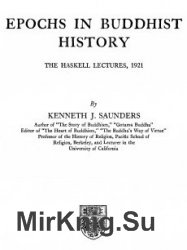Epochs in Buddhist History the Haskell Lectures
- Добавил: Energy555
- Дата: 10-04-2019, 19:45
- Комментариев: 0
 Название: Epochs in Buddhist History the Haskell Lectures
Название: Epochs in Buddhist History the Haskell LecturesАвтор: Saunders Kenneth J.
Издательство: The University of Chicago Press
Жанр: Религия
Год издания: 1924
Страниц: 291
Язык: Английский
Формат: PDF
Размер: 10 Мб
Книга Кеннета Сандерс (автор "Готама Будда" и "Буддизма в современном мире") изданная на основе лекций прочитанных им на Хаскелловских лекциях (при Чикагском университете) в 1921 году. Автор даёт экскурсы в буддийскую историю на основе отдельных шагов, совершённых это религией через разные места и эпохи. Автор часто (и, скорее, слишком настойчиво) пытается сопоставить отдельные буддийские школы с христианскими и сопоставить буддийские философские направления с западными (материализм, реализм, номинализм, идеализм, агностицизм, пантеизм и т.д.). Книга написана со вкусом и любовью, хотя для автора буддизм есть явление "внешнее", а не внутреннее, что также отмечали рецензенты.
That Buddhism is a stream which has its source in the complex and elusive system of Brahmanisnj known today asH induism; that it is rightly called by the name of Gotama Buddha, the great moral reformer of the sixth century B.C. because he shaped its course and purified its waters ;that as the stream flowed in an eve widening bed out over the Eastern World, tributaries poured into it from every side, swelling, coloring, and sometimes defiling it all this is generally accepted. This, book is an attempt to describe that remarkable process; as in the case of the great sister-religion, Christianity, it is difficult to say anything which does not need qualification. The tributaries of both religions are many and diverse, and the streams are very complex. In Buddhism, in the first place, there are several philosophical systems, ranging from a naive realism to a subtle mystical pantheism, and all claiming to be derived from the words of Sakyamuni. The person of the Founder has, in the second place, played a widely different rdle in different from that of an ethical teacher, supernormal, but not supernatural, to that of supreme god gods. In the third place, the moral reform ,he is so justly famous has been variously int different emphasis has bepn placed now upon one upon another part of his teachings, until the world finds itself divided between the self-centered individualistic mind-cultufg, hand, and a passionate, altruistic self-I other.
Оглавление
Prefatory Notes 15
Chapters 23
I. Rajagaha; the Middle Path 23
II. Patali-putra; the Spread of the Dhamma and Its Safeguarding 51
III. Gandhara and Purus apura; the Birth of Mahayana 71
IV. Nalanda; the Early Schoolmen of the Mahayana 98
V. Mihintale, Arimaddana, and Sukhothai; Fastnesses of the Theravada in Ceylon, Burma, and Siam 133
VI. Loyang, Chang-an, T’ien T’ai ; Buddhism in China 148
VII. Keum Kangsan, Nara, Hieisan, Koyasan; Buddhism in Korea and Japan 188
VIII. Svayambhu-Nath and Lhasa; Buddhism in Nepal and Tibet 236
Appendices 254
I. Fa-Hian in Lanka 254
II. Some Buddhist Prayers and Vows 259
III. Synonyms of Nibbana and Nirvana 264
IV-VI. Charts of the Buddhist Schools of India, China, and Japan 266
Index 271
Внимание
Уважаемый посетитель, Вы зашли на сайт как незарегистрированный пользователь.
Мы рекомендуем Вам зарегистрироваться либо войти на сайт под своим именем.
Уважаемый посетитель, Вы зашли на сайт как незарегистрированный пользователь.
Мы рекомендуем Вам зарегистрироваться либо войти на сайт под своим именем.
Информация
Посетители, находящиеся в группе Гости, не могут оставлять комментарии к данной публикации.
Посетители, находящиеся в группе Гости, не могут оставлять комментарии к данной публикации.
